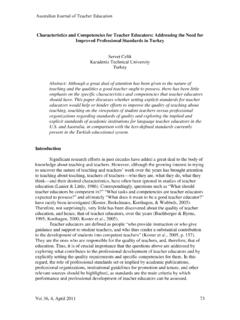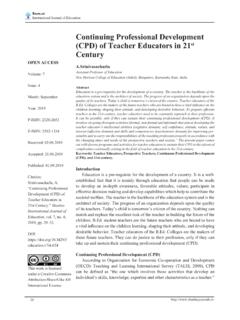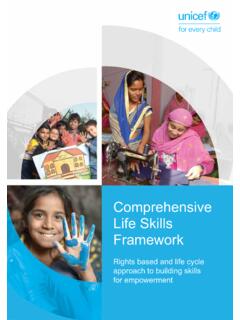Transcription of 5&$)*/( $0.1&5&/$: 4UBOEBSET - SEAMEO
1 TEACHING COMPETENCYS tandardsIN SOUTHEAST ASIAN COUNTRIESELEVEN COUNTRY AUDITSIREPA SEAMEO INNOTECHREGIONAL EDUCATION PROJECT SERIEST eachingCompetencyStandardsin Southeast Asian Countries:ELEVEN COUNTRY AUDITP hilippine Copyright 2010 SEAMEO INNOTECH ISBN 978-971-0487-40-0 All Rights Reserved. No part of this publication may be reproduced, stored in a retrieval system, or transmitted in any form or by any means without prior permission of SEAMEO INNOTECH. of Figures and Tables Acknowledgements Acronyms and Abbreviations Executive Summary Part I: The Project at a GlanceObjectivesResearch QuestionsMethodology and Research Design Scope and Limitations of the Study Significance of the StudyPart II: Attributes of a Competent teacher in Southeast Asia1. The ContextPedagogical Skills Student Assessment Skills Skills Essential to Effectively Manage a Classroom Professional Development Skills 2.
2 Other Teaching competencies of Southeast Asian TeachersProfessional Ethics and MoralitySocial and Human Dimension CompetenciesPart III: Policies and Process for Developing Teaching Competency Standards1. Policies Supporting the Development of Teaching Competency Standards in Southeast Asia Brunei Darussalam Cambodia Indonesia Lao PDR Malaysia Myanmar Philippines Singapore Thailand Timor-Leste Vietnam 2. Process for Determining Teaching Competency Standards in Southeast Asia Brunei Darussalam Cambodia Indonesia Lao PDR MalaysiaMyanmar Philippines vviiviii16788101011111215171921212122232 3232324242525252626272728282829292930 Singapore Timor-Leste Vietnam 3. Teaching Competency Standards Information Dissemination ApproachesPart IV: Assessment and Monitoring of Teaching Competency Standards in Southeast Asian Countries Brunei Darussalam Cambodia Indonesia Lao PDR Malaysia Myanmar Philippines Singapore Thailand Timor-Leste Vietnam Part V: Rewards and Incentives for Performing TeachersBruneiCambodia Indonesia Lao PDR Malaysia Philippines Singapore Thailand Timor-Leste VietnamPart VI: Competency Framework of Southeast Asian Countries Brunei Darussalam Cambodia Indonesia Lao PDR MalaysiaMyanmar Philippines Singapore Thailand Timor-Leste Vietnam Developing a Competency Framework for Southeast Asian Teachers of the 21st Century303030313232333333343434353535363 7383838383839393939394041444752555960676 8697172ivPart VII.
3 Summary, Conclusions, and Recommendations SummaryRegional Domains on Strands of Teaching Competency StandardsCommon Approaches in Developing Teaching Competency StandardsPhase I Benchmarking with Developed EconomiesPhase II Creating a Team/Technical Working Group/Pool of Experts at the Ministry LevelPhase III Pilot Testing of the First DraftPhase IV Rollout and Full Implementation of National Teaching Competency StandardsPhase V Monitoring and ReviewsCompetency Framework for Southeast Asian Teachers of the 21st CenturyConclusions and Recommendations Bibliography Annex A: Survey Instrument Annex B: Finalized Competency Framework for Southeast Asian Teachers of the 21st Century List of Figures and TablesFiguresFigure 1 Research Framework Figure 2 Major Strands of Teaching Competency Standards in Southeast AsiaTablesTable 1 Pedagogical Skills of a Competent Southeast Asian teacher Table 2 Student Performance Assessment Skills that Southeast Asian Teachers Should PossessTable 3 Classroom Management Skills Competent Southeast Asian Teachers Should PossessTable 4 Professional Development Skills Competent Southeast Asian Teachers Should PossessTable 5 Processes Used to Implement Teaching Competency StandardsTable 6 Teaching Competency Standards Information Dissemination MethodsTable 7 teacher Rewards and IncentivesTable
4 8 Major Strands/Domains of Teaching Competency Standards in Southeast Asia747475787878787878798082859197613161 82027313777vForewordIt has been extolled time and again that teaching is a noble profession. Equally recognized is the observation that teaching as a profession is a highly complex activity which benefits from ongoing reflection and continuous refinement. The tasks of continually looking within and improving oneself are the imperatives placed upon the teaching profession. This is so because, as the growing body of research has revealed, teacher quality is the most significant school-related influence on a child s academic performance, and classroom teachers more than class size and previous student achievement are the single most important factor that adds value to student a quality teacher in every classroom is a goal all Ministries of Education aspire to attain.
5 But we need to be more explicit about what teachers know and do, about what teachers need to know, and how well they need to perform in order to become more effective. The existence of teaching competency standards represents an agreed definition for quality competency standards have been developed, implemented and monitored in different parts of Southeast Asia. These standards were based on the respective contexts of the individual countries. But as the study by the Southeast Asian Ministers of Education Organization Regional Center for Educational Innovation and Technology ( SEAMEO INNOTECH) has indicated the findings of which are described in the subsequent pages of this book concurrences and overlaps abound as well. This is because, at the simplest level, competent teachers do display common attitudes and behaviors.
6 But more importantly, these regional congruities signify the different countries intention to work towards the harmonization, complementation and benchmarking in the area of capacity-building, teacher exchange and lifelong SEAMEO INNOTECH Competency Framework for Southeast Asian Teachers of the 21st Century that has resulted from this study is also one testament that the desire to develop and improve teacher quality in the region is as strong, if not more so, as it has ever been. We are optimistic that more spaces and opportunities will arise for the continued advocacy and re-conceptualization of quality teaching in our midst. Since quality teaching advances our students achievements and success, it behooves our educational community and other stakeholders to continually define and refine our understanding of what an effective Southeast Asian teacher in the 21st century and beyond should be, and how we can bring our teachers to this ideal standard.
7 Ramon C. Bacani Director SEAMEO INNOTECHT eaching Competency Standards in Southeast Asian Countries: Eleven Country AuditviiAcknowledgmentsThis report was made possible by the generous contributions of ministry officials, teacher education experts, and researchers from Southeast Asia. The experts names and the country they represent are listed DarussalamHabibah BTE SionSaliha LadiSinah SisaZainalanidin KepliCambodiaNeou SunIndonesiaMaria WidianiBaedhoni dan HartoyoLao PDRD aravone KittiphanhMalaysiaZaida MustafaMyanmarDaw Myint MyintPhilippinesBeatriz G.
8 TornoAmor Q. de TorresSingaporeMa. Christine P. TambyahThailandSangob IntaramaneeTimor-LesteCidalio LeiteVietnamPhuong Thanh MyWe hope that this report will be useful to dedicated teacher educators and will be a great help to the countries that are still preparing their national teaching competency Competency Standards in Southeast Asian Countries: Eleven Country AuditviiiAcronyms and AbbreviationsALS Alternative Learning SystemASEAN Association of Southeast Asian NationsCHED Commission on Higher EducationCSC Civil Service CommissionDEB District Education BureauDepED Department of EducationDEPT Department of Educational Planning and TrainingDOP Department of PersonnelDTE Department of teacher EducationEDMP Educational Development Master PlanEPMS Enhanced Performance Management SystemICT Information and Communication TechnologyIPPD Individual Plan for Professional Development IT Information TechnologyLET Licensure Examination for TeachersLGU Local Government UnitMOE Ministry of EducationMOET Ministry of Education and TrainingMoEYS Ministry of Education, Youth.
9 And SportsMONE Ministry of National EducationMQA Malaysian Qualifications AgencyNCBTS National Competency-Based teacher StandardsNCTC National Charter of teacher CompetenciesNESB National Education Standards BoardPDR People s Democratic RepublicPRC Professional Regulation CommissionRSU Research Studies UnitSEAMEO Southeast Asian Ministers of Education OrganizationSEAMEO INNOTECH Southeast Asian Ministers of Education Organization Regional Center for Educational Innovation and TechnologyTeaching Competency Standards in Southeast Asian Countries: Eleven Country AuditixSEAMEO RIHED Southeast Asian Ministers of Education Organization Regional Centre for Higher Education and DevelopmentSIREP SEAMEO INNOTECH Regional Education ProgramSPN21 New Education System of the Twenty-First CenturyTDA Training and Development AgencyTEC teacher Education CouncilTED teacher Education DivisionTEDP teacher Education and Development ProgramTEI teacher Education InstitutionTESAP teacher Education Strategy, 2006 2015 and Action Plan, 2006 2010 TIP teacher Induction ProgramTSNA teacher Strengths and Needs AssessmentUN United NationsUNDP United Nations Development ProgrammeUNESCO United Nations Educational, Scientific.
10 And Cultural OrganizationUNICEF United Nations Children s FundTeaching Competency Standards in Southeast Asian Countries: Eleven Country Audit1 ExEcutivE SummaryThis report focuses on the status of development, implementation, and monitoring of teaching competency standards in Southeast Asian countries. The development of teaching standards has been a growing feature of the global education agenda since the inception of the Dakar Framework during the World Education Forum held in Dakar, Senegal, on 26-28 April 2000 to provide quality education that will give learners the opportunities for effective participation in the societies and economies of the twenty-first century. Southeast Asian countries have actively participated in the global agenda in pursuit of international development goals.









